white supremacy

1. Character matters
In 2016, we heard the recording of Donald Trump bragging that he could grab women by the genitalia and kiss them without consent. This reveal of sexual abuse was a blinking red warning sign: “No character!” But most white American Christians voted for him anyway. Now hundreds of thousands of Americans are no longer with us. Children are dead, separated from their parents, neglected and abused in our detention centers. Police continue to kill unarmed Black people with impunity. Evidence shows that wherever there is violence against women, there will also be violence against ethnic minorities and the land. Character matters.
2. Our votes matter
If you ever doubt that, remember 2020: body bags, 175 cities on fire, food lines, closed businesses, fears for the future, the president having tear gas shot into a crowd so he could walk across the street and hold a Bible in front of a church he doesn’t attend. Let us learn that a non-vote is a vote for the winner. In a democracy, votes have the power to bless or curse millions. It is our civic duty to approach elections as informed citizens. It is our Christian duty to leverage elections to protect the least of these.
OUR AUGUST 2020 article “Harboring a Culture of Hate,” by Catholic scholar-activist Eric Martin, contended that since the U.S. Catholic bishops did not explicitly condemn the Confederate flag as a symbol of hate—the bishops’ committee said “some still claim it as a sign of heritage”—some Catholics believe it is acceptable to be both Catholic and a member of white supremacist movements. Some Catholic officials and laypeople called the article misleading, saying it unfairly downplayed the institutional church’s other important anti-racist work, and Sojourners’ president Jim Wallis, who was then also editor-in-chief of our publications, decided to remove the article from our website.
Two weeks later, after some of the most intense and voluminous reaction in our publishing history, we issued a correction and reposted the article—and we’ve made some significant structural changes as well, instituting new policies that establish editorial independence from our organizing work (our new editor-in-chief Sandi Villarreal explains the importance of editorial independence). We’ve received hundreds of responses from our readers—including ordained and lay Catholic leaders, journalists, scholars, and activists—a sampling of which is below. As always, we appreciate your honest and passionate engagement, and we promise to keep listening.
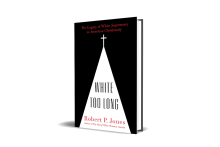
Every nonfiction book is personal, often arising from some faint but persistent insight, a kernel of awareness that blossoms into a story that demands to be told. White Too Long began with a growing consciousness of the abiding presence of white supremacy within the faith we white Christians have inherited and live within.
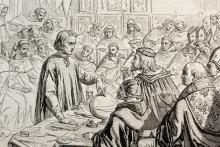
“WHITE CHRISTIANITY IN America was born in heresy.”
This statement was made by Yale University theologian Eboni Marshall Turman last year before a large gathering of religion scholars. Marshall Turman, a formidable leader in African American theology, did not explain her meaning. In that room, she did not need to do so.
But as I heard her, I thought dolefully about how very long it took me as a white American Christian ethicist to be ready to engage or even to understand such a statement. I wondered doubtfully how many white American Christians today would be prepared to discuss it rationally. After all, part of what is so deeply wrong with white evangelicalism has to do with race. If what comes “after evangelicalism” does not address our racism at its roots, we shouldn’t bother.
To say that white Christianity in America was born in heresy is to make a theological statement about racism prior to any moral evaluation. It is to suggest that our local racism problem is ultimately rooted in heresy, a violation of central tenets of Christian doctrine. It is also to say that this heresy was present from the birth of American Christianity. There was no original innocence—the heresy and its resulting sins were there from the beginning.
This begs the question of whether the ultimate historical source of such heresy can be identified. It seems to me that a compelling starting point is 15th century Europe as it began conquering and colonizing the world in the name of Christ. The story begins with those first imperial powers, Spain and Portugal, but soon after extends to Britain and other European colonial nations, including Holland, France, Belgium, and so on. These were empire-building nations on the cusp of their grand adventures. They confidently believed themselves to be the center of the world, superior to all other cultures, entitled to conquer and colonize, and in doing so actively advancing God’s will. The European powers believed this for many centuries. Some would say that they, and their descendants, believe it still.
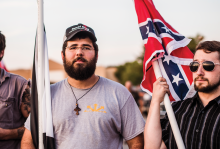
WHEN THE U.S. Catholic bishops gathered to draft a document on race in the wake of the 2017 white terrorist rally in Charlottesville, Va., Bishop Anthony Taylor of Little Rock, Ark., submitted an amendment to condemn the imagery of swastikas, Confederate flags, and nooses. The U.S. bishops deliberated and voted to reject it.
The document, “Open Wide Our Hearts,” was billed as “a pastoral letter against racism,” making its writers’ inability to adopt the amendment condemning three famously extreme symbols of racism a curious one.The bishops explained themselves by arguing that swastikas and nooses were already “widely recognized signs of hatred,” which would seem to make them all the easier to condemn. (Interestingly, they eschewed this logic when issuing their only condemnation, against violence toward police.) As for the Confederate flag, “some still claim it as a sign of heritage,” they argued.
While this logic indefensibly hand-waves the history of slavery, murderous opposition to civil rights, and violence such as the 2015 shooting at a Black church in Charleston, S.C., as a vaguely benign “heritage,” it also fails to account for the flag’s use among those with no ties to the Confederacy. Take, for example, U.S. Rep. Steve King. While most widely known for asking what’s so wrong with white supremacy and white nationalism, King, who is Catholic, has also displayed a Confederate flag on his congressional desk. The quite obvious meaning of the flag’s presence on the desk of King, who represents a district in Iowa until January, is apparently lost on the bishops, given their claims about “Southern” heritage.
The decision to avoid condemning swastikas, nooses, and Confederate flags would be troubling under any circumstances. But this moral failure is compounded by the fact that Catholics are among the most integral groups that rally behind these symbols. From the highest reaches of government to the lowest depths of social media, many members of hate groups and politicians who model their talking points are part of the bishops’ flock. Catholics not only contributed to the platform for the so-called alt-righters who terrorized Charlottesville and killed Heather Heyer but are leaders and even founders of the most dangerous neo-Nazi groups in existence.
The Catholic Church, once persecuted by the Ku Klux Klan, today has a visible white-power faction. As long as the bishops actively refuse to condemn its banners, they give white supremacists space to embrace their anti-Black and anti-Semitic work free of religious dissonance.
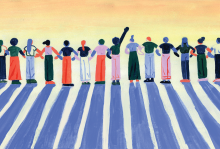
A WHITE COP’S knee on the neck of a Black man revealed the old and ongoing pandemic underneath the current pandemic. The coronavirus had already laid bare the systems of racial injustice that accelerate the spread of sickness and death among people of color—the fundamental racial disparities in health care, economics, housing, education, and every other institution in America. Structural racism was exposed as a precondition for getting and dying from COVID-19; white supremacy is the virus that has made America’s soul sick for 400 years and continues to kill Black people.
Over the last weekend in May, including Pentecost Sunday, Sojourners helped organize faith communities to lament the first 100,000 COVID dead in this country. We were joined by Muslim and Jewish brothers and sisters in their services, and we helped unite Christian families across all our divisions—mainline Protestant, evangelical, and Pentecostal, Catholic, Black, Hispanic, Asian American, and Native American Christian leaders and their congregations—in honoring and memorializing those who died from the virus in only three months, many of them separated from their loved ones. On June 1, we were joined by mayors from more than 60 cities who, with interfaith clergy, announced a Day of Mourning and Lament.
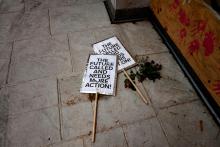
While many Americans, especially white Americans, expect the police to protect their privileges, they often criticize police for the tactics used to protect those privileges. While people should indeed be appalled by racialized police violence, racialized policed violence is actually a symptom of the underlying pandemic of racism — a socially constructed malady designed to protect white privilege.
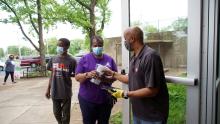
I was never concerned that there could be consequences for crossing a main road that separated our immediate neighborhood from the adjacent one, or that the Confederate flags I passed along my route might be intended as a “no trespassing” sign for people who looked like me. I wasn’t Ahmaud. Scores of childhood friends donned camo and lugged military-style toy rifles from yard to yard as we replayed World War II battles. No one worried a police officer, or a neighborhood vigilante, patrolling our streets would mistake us for a real threat. We weren’t Tamir Rice or Trayvon Martin.
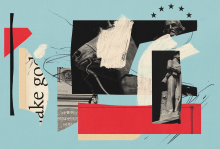
EVERY DAY, BEFORE the coronavirus had us sheltering in place, I drove by a Confederate monument on the state capitol grounds near my home in Raleigh, N.C. It was unveiled in 1895 by the granddaughter of Stonewall Jackson, Julia Jackson Christian. Its 75-foot-tall granite column is a fixture of the landscape as people walk past on their way to work or sit on benches beneath its shadow, the shaft marked with the words “to our Confederate dead.”
The monument is strategically placed to assure maximum visibility. Everything about it is purposeful and planned. It makes a claim on the space—claiming the ground, the air, the power of public land with a particular version of history.
“To our confederate dead.” But the question that burns on the stone: Who does “our” represent?
Injustice, idolatry, and repentance
IN 2019, CHARLOTTESVILLE, Va., was still reeling from the August 2017 Unite the Right weekend during which counterprotester Heather Heyer was killed by a white nationalist. Two local Methodist pastors—Rev. Isaac Collins and Rev. Phil Woodson—decided to gather community members for a weekly Bible study aimed at reinterpreting the Confederate monuments that mark Charlottesville’s public space. They called it “Swords into Plowshares: What the Bible says about injustice, idolatry, and repentance.”
The inspiration came from Jalane Schmidt, a public historian and religious studies professor at the University of Virginia in Charlottesville, who has co-led truth-telling tours of the monuments since 2018. Schmidt suggested Collins take up the work of theological interrogation of the history embedded in these monuments and how this history lives on in the churches and Christians in their city.
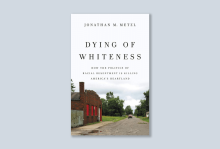
IMAGINE A MAN seized by a demon. He cannot be bound by chains or confined within walls. He is a danger to himself and everyone around him. In Dying of Whiteness, Jonathan M. Metzl lays out a compelling case that white folks are so convinced of an ideology of whiteness that we are willing to kill, and even to die, for it. One Christian way to talk about this would be to say that white people are possessed.
In his book, Metzl examines three public health case studies: gun culture in Missouri, particularly white male suicide; the failure to expand Medicaid in Tennessee; and the gutting of public schools under cruel budget and tax policies in Kansas. For each, he calculates the years of life lost because of poor political decisions made under an ideology of white supremacy.
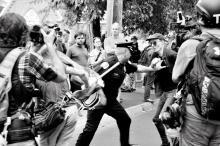
As a result of the political, religious, and moral crises we face today, both the soul of the nation and the integrity of faith are now at stake. This crisis is fundamentally about our chance and our choice of whether those who call themselves Christians are ready to go back to the teachings of Jesus, and whether such a call might be taken up by others beyond the churches. Many of us share a deep hunger for reclaiming Jesus instead of falling into more political polarization — we want theology to trump politics.
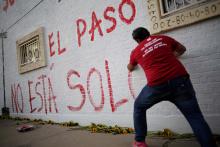
Some Latinx people have known — and others have suspected — this land is not safe for us, but the extent to which that suspicion has been confirmed in El Paso is terrifying. The perpetrator in this massacre was deliberate in his plan to counter the “Hispanic invasion.” It’s tempting to believe all this has been incited by the current president’s violent rhetoric. But while that rhetoric has added much fuel to the fire, the fire has been burning for a long time.
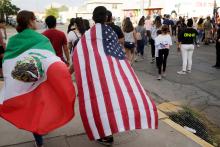
Though Juarez is known as a center of cartel- and smuggling-related violence, El Paso is rated on various websites as one of the safest cities in America and among the best places to retire or raise a family. According to KVIA, a local ABC affiliate, it averages 16 murders a year.

FOR A GOOD SIX MONTHS, I didn’t notice the words carved above the grand sanctuary entrance to Mount Vernon Place United Methodist Church in Washington, D.C. The letters stand guard over the doors like sentries: Methodist Episcopal Church, South. The words meant nothing to me.
In February, the General Conference of the UMC voted to strengthen the enforcement of denomination rules against ordaining LGBTQ Christians and performing marriage ceremonies for LGBTQ couples. But Mount Vernon Place (MVP) has long described itself as “young and old, gay and straight, liberal and conservative, housed and unhoused, people filled with faith and people who know doubt.” It struck me as a place I could fit in and be challenged.
On my first visit, I was intrigued by a bulletin notice announcing the launch of a racial-justice book group—especially since the congregation is predominantly white. So I joined.
Book group leader Caroline Anderson-Gray, white and in her 30s, has been a member at MVP for four years. I asked her why she started MVP’s racial justice conversation with a book group.
“In the summer of 2016, as reports of police officers killing black citizens seemed to be at the top of the news every other day, our minister raised the idea of a racial-justice reading group,” said Anderson-Gray. “I believe that to be Christian is to be committed to dismantling structures of hatred and inequality, so a reading group on the subject of racial justice at church made a lot of sense to me. By the time we had our first meeting, the presidential election had occurred, and the need for such a group was more urgent than ever.”
A book group may not seem like much given the rise of social terror. But small discipleship groups are a very Methodist practice—and this one opened a space for transformative conversations. Eight to 12 people, a microcosm of the church, gathered every other month to read and learn. One man, a Canadian expatriate, spoke about his difficulty in understanding his new country considering the experiences of his African-American husband. Una Song, an MVP member for three years, said that reading Patricia Raybon’s My First White Friend helped Song clarify her own experiences of exclusion in a country dominated by white privilege.

BLACK AND BROWN folks have discussed at great length white supremacy and empire, but unless white folks have the conversation, those demons will never be fully cast out of our lives. White folks have become content with a lifestyle that hovers above black and brown folks and doesn’t dive into the white supremacy and empire that threatens them.
But Greg Jarrell, author of A Riff of Love: Notes on Community and Belonging and a self-described “white, middle-class, highly educated, straight man,” departs from this pattern. Jarrell plunges into the issues, examining the story of his family’s more-than-a-decade-long journey of building QC Family Tree, an antiracist spiritual community of people in solidarity with black folks experiencing gentrification and displacement in the Enderly Park neighborhood of Charlotte, N.C.
Jarrell, who plays saxophone, frames the book around the concept of riffs, which he describes as “a few notes ... the essence of the full melody, the foundation from which a whole work is constructed.” Some of the greatest jazz arrangements begin with a riff, born of careful attention to a melody and improvisation on a theme.
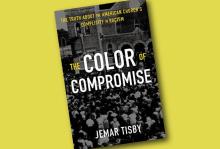
A HAUNTING, emotionally charged, fact-based narrative, The Color of Compromise: The Truth about the American Church’s Complicity in Racism covers 400 years of American civil rights history. It is a withering look at the role white Protestant churches played in reinforcing institutional support of slavery and racism. Its main thesis is that moderate Christians have had the clout to rebut racism but have an abysmal record of doing so. This story is woven from a survey of biographies, memoirs, classics of history, and serious journalistic research.
White moderates, Jemar Tisby demonstrates, time and again mouthed sympathetic clichés toward the black community but inevitably supported the status quo. Probably the most iconic example Tisby gives is that of Billy Graham, one of the most prominent Protestant figures of the 1950s and 1960s.
Graham talked a good game: He publicly removed ropes segregating black churchgoers at his massive rallies. But despite these “positive” optics, Graham never participated in civil rights demonstrations. He instead insisted that civil rights was a local matter. He railed against communism, feeding into the term’s use as coded language that marked “subversive” U.S. political activity as evidence of Soviet influence. When the Watts riot broke out in Los Angeles, Graham quickly declared that “rioting, looting, and crime ... have reached the point of anarchy,” while failing to explain the profound issues that caused the rebellion.
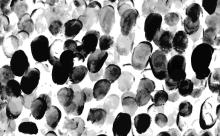
White supremacy is woven and embedded into society as a system so intricately that it can be invisible, mistaken for normalcy because, in fact, that’s what it is. Instead of seeing white supremacy as blatant acts of intentional harm, I challenge us to consider how this country was built to center whiteness. It’s a virus and an energy. It is a virus because it is a sickness at the core of so much harm, and it’s an energy because in its natural state — this country is conditioned to operate in accordance with whiteness: white culture, white thriving, white favoritism, and white comfort.
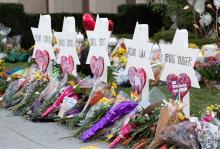
JUST DAYS BEFORE the midterm elections, the Sojourners community reacted with shock, mourning, and fear at the horrific and murderous attack on the Tree of Life synagogue in Pittsburgh. Eleven congregants were killed while observing the Sabbath in the deadliest attack on the Jewish community in U.S. history.
That this evil act of anti-Semitic terrorism should take place here in the United States is deeply shocking. Yet both U.S. and world history teach us that the poison of anti-Semitism is very real and has deadly consequences. Anti-Semitism is one of the oldest and most persistent forms of bigotry alive in the world today, and Christians—who believe all human beings are created in the image of God—have a duty to name anti-Semitism and confront it at every turn, particularly given the shameful complicity of so many Christians in the Holocaust and other oppression and killing of Jewish people.
This hate crime capped off a horrific week of violence inspired by white supremacist ideology, in which racist and conspiracy theories were openly promulgated on the campaign trail by Donald Trump and amplified by prominent voices in right-wing media and dark web spaces. The attempted murder of critics of the Trump administration by mailing pipe bombs, the killing of two African Americans—Vickie Lee Jones and Maurice Stallard—in a grocery store after a failed attack on a black church, and the massacre of Jews in their synagogue—all were carried out by white supremacist nationalists, who are the greatest terrorist threats in America today.
In his closing election messages, Trump was unashamedly using a political strategy of fear and hate. The violence we have seen cannot be disconnected from the bigoted and hateful words of presidential political rhetoric. When the president proudly called himself “nationalist,” amid such hate and violence, the white nationalists, supremacists, and anti-Semites felt supported and emboldened.
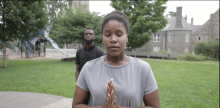
On Aug. 12, 2017, I woke up keenly aware that I might die. I reflected on this reality during my drive to Charlottesville, Va., with plans to stand up for love and peace against white supremacy. I left Charlottesville physically unharmed, but scarred for life. I was scarred by the fact that Heather Heyer had been killed, that people, including friends, were injured in the terrorist attack, that my life had been blatantly threatened numerous times with people who chanted racial epithets and glared at me with their rifles, and that I had personally witnessed such intense vitriol towards my very existence. I drove away convinced that I would never return.
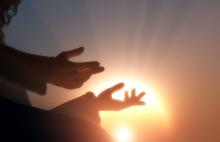
This is not a time for the marketplace of ideas. There are people who believe that immigrant children are criminals. There are people who act as though queer folks are an abomination. There are people who consider every black and brown person to be a threat. These ideas are not worth debating. Logical conversations will not dissuade oppressors. Civility has never transformed the reality of the marginalized and it never will.